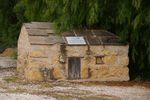
Home » Themes » Landscape » Settlement
Moorundie CairnPrint Page 
The cairn commemorates the first European settlement on the River Murray in South Australia. It was built by schoolchildren as part of a history project. The Blanchetown Community Association funded the project built of local stone and slate in the shape of an early settler’s cottage.
The Blanchetown Community Association funded the project which is built of local stone and slate in the shape of an early settler's home. A willow taken from the willow tree at E. J. Eyre's original homesite, and documented as coming from Napoleon`s grave, has been planted nearby. The project was complete in 1986.
Location
| Address: | The Parade, Opposite Lock 1, Blanchetown, 5357 |
|---|---|
| State: | SA |
| Area: | AUS |
| GPS Coordinates: | Lat: -34.350643 Long: 139.615105 Note: GPS Coordinates are approximate. |
Details
| Monument Type: | Monument |
|---|---|
| Monument Theme: | Landscape |
| Sub-Theme: | Settlement |
| Approx. Event Start Date: | 1986 |
Dedication
Approximately 5 kms south of Blanchetown on the banks of the River Murray lies the site of the historic settlement of Moorundie. The settlement was named after a local aboriginal tribe, and parts of it were later surveyed and named the Village of Sturt.
Edward John Eyre, famous Explorer and Protector of Aborigines, established himself in Moorundie in 1841, in an attempt to quell the growing conflict between the Overlanders and local aborigines. Eyre returned to England in 1844 and was replaced at first by E.Nation, and then by Edward Bate Scott, who acted as Sub Protector of Aborigines and Police Inspector.
Between 1841 and 1856, Moorundie served as an important aboriginal contact point, rations depot, experimental irrigation settlement and Police Outpost. The settlement also included a port, later to become the final resting place for the Government Survey Cutter, The Water Witch.
Continual flooding eventually put an end to Moorundie and Blanchetown was established high on the cliffs overlooking the river. Blanchetown was surveyed iin 1885 and named after Lady Blanche, wife of the colony's sixth Governor, Sir R. G. MacDonnell.
The site of Moorundie has been placed in the Register of State Heritage Items because of its historical and cultural significance.





